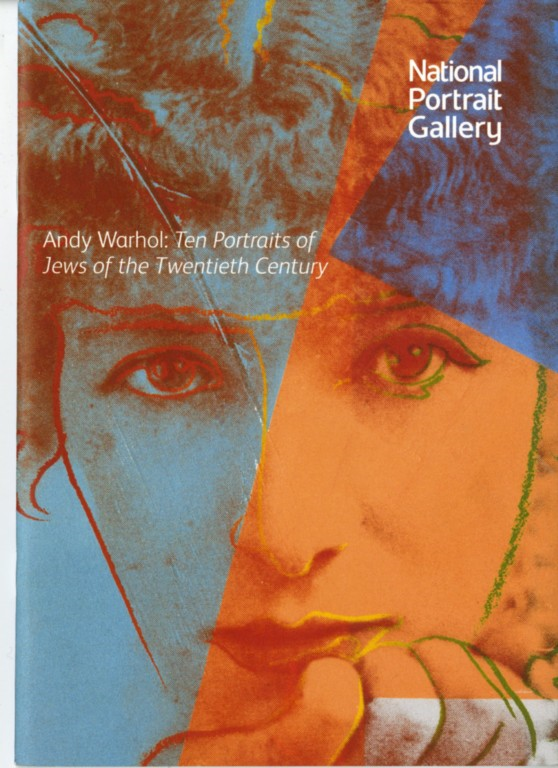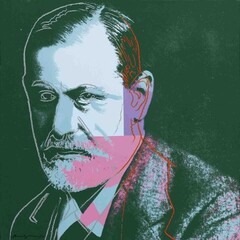Details
| Autor | Nairne, Sandy |
|---|---|
| Herausgeber | National Portrait Gallery, London (Hg.) |
| Verlag | National Portrait Gallery, London |
| Auflage/ Erscheinungsjahr | 2006 |
| Einbandart/ Medium/ Ausstattung | Paperback |
| Seiten/ Spieldauer | 16 Seiten (unpaginiert) |
| Abbildungen | 22 Abb. |
| SFB Artikelnummer (SFB_ID) | SFB-000677_GL |
16 page booklet to accompanying the National Portrait Gallery Balcony display.
Zu dieser Publikation
This unpaginated gem of a catalogue (6 x 81/4 inches) has 16 pages with 22 illustrations, excluding the cover front and back, which are larger reprises of images inside. This elegantly designed 6 inch by 8 1/4 inch volume was published to accompany the display »Andy Warhol: Ten Portraits of Jews of the Twentieth Century« at the National Portrait Gallery, London, from 24 January to 2 July 2006. Featured are images of Martin Buber, Golda Meir, Albert Einstein, Sandra Bernhardt, Louis Brandeis, Sigmund Freud, the Marx Brothers and others. The catalogue is softcover with illustrated wraps and elegant purple French folding flaps. “Hidden” behind each flap is a full page portrait (shown with flap open).
»Andy Warhol is widely recognised as one of the most significant artists of the late twentieth century, and Ten Portraits of Jews of the Twentieth Century is, arguably, among his most important paintings. However, twenty six years after it was created and first exhibited, numerous questions remain about the artist's intentions and the work’s meaning. A pantheon of great thinkers, politicians, performers, musicians and writers, Warhol's great sequence of portraits of ‘Jewish geniuses’ was originally shown at The Jewish Museum, New York in 1980. Arching across the century, the breadth of achievement represented by these figures is formidable. Indeed, the selection seems calculated to touch every aspect of human experience. The line-up comprised: Sarah Bernhardt, the celebrated French stage actress; Louis Brandeis, the first Jewish judge to be appointed to the Supreme Court of the United States; Martin Buber the renowned philosopher, story-teller and pedagogue; Albert Einstein, one of the greatest scientists of the twentieth century; Sigmund Freud the hugely influential founder of the psychoanalytic school of psychology; the Marx Brothers, celebrated comedians of vaudeville, stage and cinema; Golda Meir, one of the founders of the State of Israel; George Gershwin, the distinguished American composer; Franz Kafka, the major German writer, and Gertrude Stein, the important American novelist. Even so, the critical response to the show was decidedly mixed and, at times, intensely hostile. The New York Times was unsparing: ‘the show is vulgar, it reeks of commercialism, and its contribution to art is nil’. In sharp contrast, Art Forum argued: ‘the paintings are staggering’, and it noted ‘an unexpected mix of cultural anthropology, portraiture, celebration of celebrity, and study of intelligentsia – all at the same time’. The paintings are a remarkable achievement and in many ways represent a peak in Warhol’s oeuvre. Magisterial in conception, they advance a new subtlety and sophistication in technical terms. One of their most compelling aspects is the way surface and image are held in a satisfying and fascinating dialogue, generating new depths of meaning and implication. This is due in no small part to Warhol’s combination of abstract elements with archival photographs which strike the viewer with the force of familiarity. The disjunction between sitter and surface is a visual device that unites the portraits, but the series has a conceptual unity also. Warhol's insistence that the subjects be deceased invests the series with an inescapable character of mortality. The faces of the dead appear as if behind a veneer of modernity. As individuals they belong in the past, while their image persists in the present. The tension sustained between photograph and abstraction focuses the issue of their celebrity. Probing the faultlines between the person and their manufactured, surface image, Warhol presents these individuals’ fame as a complex metamorphosis. The real has been transformed into a glorious, poignant, other-worldly abstraction. The portraits, which are on loan from a private collector, are being exhibited at the National Portrait Gallery in 2006 – the first time this controversial work has been shown in this country. The exhibition is accompanied by the publication of a new essay on this controversial work by Paul Moorhouse, Curator, 20th Century, National Portrait Gallery.« (aus dem Begleittext)
Lieferbarkeitshinweis
Bei der SFB ist die in dieser Variante extrem seltene Ausgabe als ein sehr gut erhaltenes Archivexemplar verfügbar; nicht zu verwechseln mit einer anderen Publikation des Künstlers zum Thema jüdische Persönlichkeiten.


Kommentare
Schreiben Sie den ersten Kommentar!
Neuer Kommentar
Bitte beachten Sie vor Nutzung unserer Kommentarfunktion auch die Datenschutzerklärung.